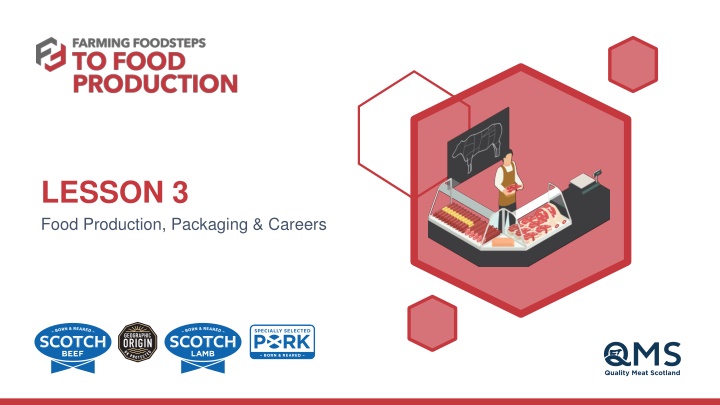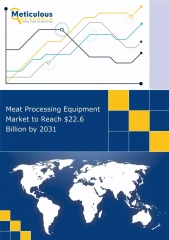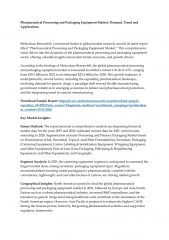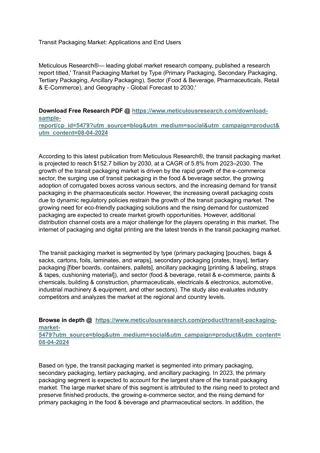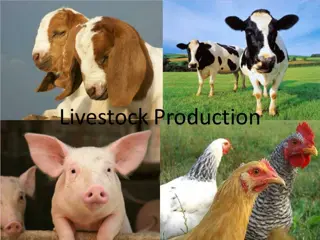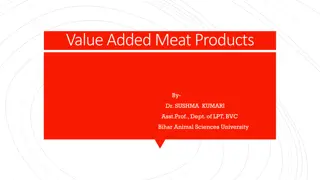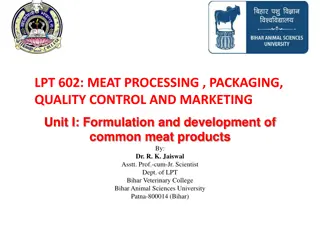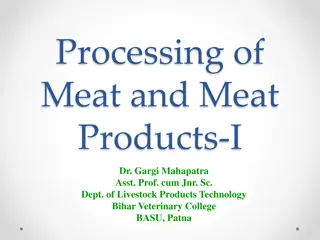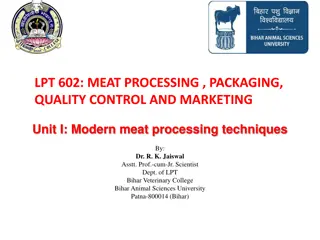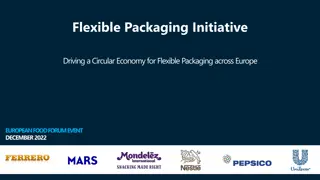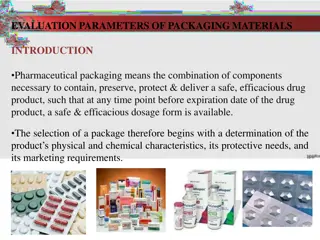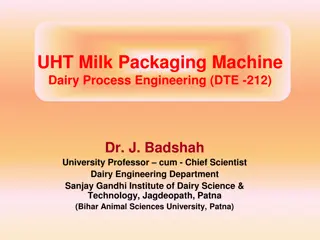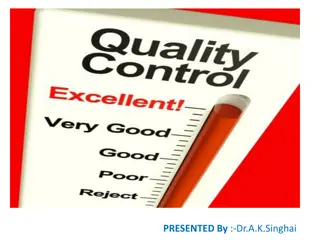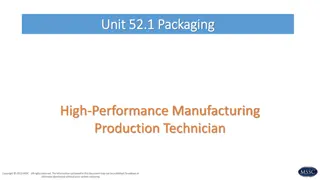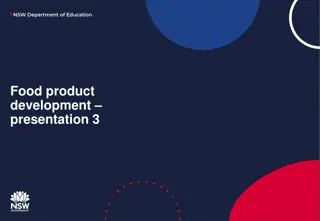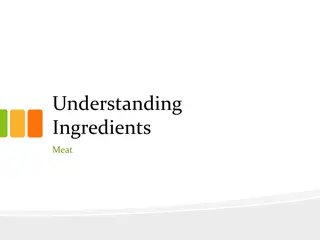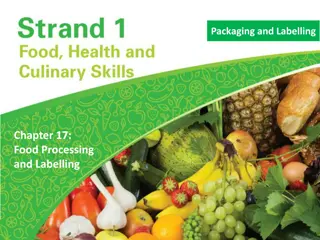Food Production, Packaging & Careers in Meat Industry
This presentation covers the production, packaging, and careers in the meat industry, focusing on red meat products from cattle, sheep, and pigs. It delves into the utilization of various parts of animals, processes in abattoirs ensuring safety and humane treatment, as well as the versatility and sources of pork and lamb/mutton. The session also touches on traceability, food security, food safety, packaging, labeling, and key points for those interested in careers within this sector.
Download Presentation

Please find below an Image/Link to download the presentation.
The content on the website is provided AS IS for your information and personal use only. It may not be sold, licensed, or shared on other websites without obtaining consent from the author.If you encounter any issues during the download, it is possible that the publisher has removed the file from their server.
You are allowed to download the files provided on this website for personal or commercial use, subject to the condition that they are used lawfully. All files are the property of their respective owners.
The content on the website is provided AS IS for your information and personal use only. It may not be sold, licensed, or shared on other websites without obtaining consent from the author.
E N D
Presentation Transcript
LESSON 3 Food Production, Packaging & Careers
Session layout This presentation will cover the following: o Red Meat Products Pigs, Cattle, Sheep o Traceability o Red Meat Food Security o Red Meat Food Safety o Packaging o Labelling o Food Processing o Careers o Key Points & Next Steps
Red Meat Products Meat is the main product that is derived from cattle, sheep and pigs but as much as possible of the carcase is used. This prevents waste and utilises the whole carcase. You may be surprised to learn what some of the other parts of the animals are used for: Bones charcoal, fertiliser, glass Hair air filters, brushes, insulation Skin leather, marshmallows, sweets, ice cream Fat chewing gum, soap, toothpaste Blood medicine, dye/ink, adhesive Lanolin grease from raw sheep s wool tape, soap, shampoo Internal organs instrument strings, medicines Hooves pet food, plant food, photo film Horns adhesive, cosmetics Brain anti-aging cream, medicine
Abattoirs Safe & Humane Cattle, pigs and sheep are slaughtered in modern abattoirs where the conditions are strictly supervised. A vet is always in attendance. Sick or injured animals are not slaughtered for meat. There are cameras monitoring the work to ensure the regulations are adhered to. Every effort is made to ensure that the operation is as humane as possible - this includes rendering the animal unconscious immediately prior to slaughter The animal carcase is initially divided into large primal quarters . These are then butchered into the various cuts, like roasting joints and steaks, and offal, such as liver and kidneys.
Pigs The main product that comes from pigs is pork. Pork is available all year-round. Fresh pork is very versatile and can be used in a variety of recipes. Pork is a good source of protein, zinc and B-vitamins. Ham and bacon also come from pigs. They re classed as processed meats as they have been processed to extent their shelf life. Many of the cuts from a pig are not utilised by consumers in the UK for example, offal and pig cheeks. These are exported to other countries. We also import pork and UK imports continue to rise, with Denmark, Germany, the Netherlands and Spain all continuing to increase shipments to the UK.
Sheep Sheep provide meat called either lamb or mutton and there are many different cuts. Sheep also give us wool, which can be used to make clothes, carpets, to make insulation and in fabrics e.g. upholstery as it has good fire-retardant properties. Lamb meat is available from around 5 months after birth and older sheep provide mutton. For lambs born in spring, they reach the shop shelves from August onwards. Lamb is also imported from New Zealand which is a journey of 11,000 it is worth checking labels before you buy.
Cattle Beef cattle give us beef. There are different cuts of beef which come from different parts of the animal. Cuts include steak, mince, shin, oxtail, flank and rib. Beef is also used in many different products: burgers, scotch pies and beef soup. Scotch Beef PGI is specially selected beef from Scotland from assured Scottish farms that must adopt best practice regarding animal welfare and natural production methods. Cattle also give us milk, leather, gelatine and cow by-products are used in several products including toothpaste and antifreeze.
What is Traceability & Why is it Important? Cattle passport Cattle tag Traceability is the ability to trace the origin of food and the journey food has made. In red meat production, traceability (from farm to fork) is important when considering the safe production of our food. If there is a problem with any of the meat produced the source can be easily traced and the issue resolved. All cattle, sheep and pigs in the UK must have ear tags. Cattle also have passports to monitor their movements.
Food Processing Foods are processed for several reasons: to extend the shelf life, e.g. making bacon convenience, e.g. ready-made lamb curry health, e.g. reduced fat mince to provide more variety and choice, e.g. pork and apple sausages to provide additional nutritional benefits, e.g. fortified breakfast cereals. making food safe to eat by killing harmful bacteria, e.g. blast freezing making foods become available that are out of season, e.g. freezing making foods easier to prepare, this is important for people who live busy lifestyles. Processing can be as simple as freezing food but it can also be complex, e.g. formulating a frozen meal with the right balance of nutrients and ingredients.
Types of Food Processing Primary Food Processing: Secondary Food Processing: Foods are processed after harvest or slaughter. Food is made into edible products. Example: cattle carcass is butchered to produce sirloin steaks. Example: beef is diced and is combined with other ingredients to make a steak pie.
Red Meat Food Security Food security is having reliable access to a sufficient quantity of affordable, nutritious food. This is something that the majority of us take for granted in this country, but incidents like the COVID-19 pandemic (empty shelves/panic buying) highlight how food security can be impacted. Factors that can affect red meat food security include: Crop pandemic Human pandemic Soil erosion Population growth Climate change International trade DISCUSSION POINT: Which of these threats are the most likely to effect Scotland in the next 20 years?
Red Meat Safety Food safety refers to handling, preparing and storing food in a way to best reduce the risk of becoming sick from foodborne illnesses. Food that is unsafe can contain harmful bacteria, viruses, parasites or chemical substances which can cause over 200 different diseases ranging from diarrhoea to cancer. World Health Organization All aspect of the red meat food chain must adhere to strict food safety regulations there are a number of regulations which are specific to animal-based products. Food Standards Scotland have a range of educational resources should you want to investigate food safety further.
Red Meat Safety Food safety is a key priority at every stage of the red meat food journey from farm to fork and is a key part of Quality Meat Scotland s assurance schemes. Farm animal health & welfare are checked and when medicine is given farmers must adhere to strict rules. Farm Feeding the feeding animals are given is carefully monitored. Abattoir animals are only accepted if they are clean and healthy. Strict cleaning procedures are in place. Meat Processers & Butchers strict cleaning procedures are in place. Home it s the consumers responsibility to maintain food safety at home ensure there is no cross contamination, store correctly, respect use by dates & cook correctly. DISCUSSION POINT: Where should fresh meat be stored in a fridge? Is this the same for cooked meat (ie. sliced ham)?
Packaging The majority of red meat products are sold in plastic packaging. Pros Cons Creates a sealed barrier to protect the food from the external environment. Extends shelf life which reduced waste. Many plastics can be recycled. Plastic is derived from petroleum/oil which is a carbon-based material which produces greenhouse gases to create. Lasts in the environment for many decades, resulting in increased use of landfill if not recycled. May end up in rivers/oceans if not recycled/disposed of correctly. Some plastic meat packaging is non-recyclable. Research is underway to develop alternative packaging materials, with a focus on safety and how packaging degrades in the environment. Many local butchers do not use plastic packaging but use paper or encourage customers to bring sealable, reusable storage boxes.
Red Meat Safety Food labelling is there to communicate with the person buying the food. Some of the information must be there by law and some information is there by choice and is designed to encourage you to purchase the product. By learning to understand what the information on labels mean it will empower individuals to make informed choices. The Make it Informed Interactive Resource has been designed to explore the information on meat packaging. There is a worksheet to accompany the resource which can be found within the Farming Foodsteps: To Food Production lesson.
Food Labelling Meat producers must show the following information: the name of the food a best before or use by date (or instructions on where to find it) any necessary warnings net quantity information a list of ingredients (if there is more than 1) the name and address of the UK business responsible for the information on the food or, if the business is not established in the UK, the name and address of the importer the country of origin, if required the lot number or use-by date any special storage conditions instructions for use or cooking, if necessary
Red Meat Logos There are several logos that can be found on red meat products. By finding out what the logos mean consumers can quickly get useful information about the product which may affect their buying decision. The organic logo can only be used on products that have been certified as organic. Born & reared in Scotland and all parts of the process are part of the QMS Assurance Scheme. Farmed organically (without chemicals) Born & reared in the UK, is traceable and products meet assurance standards. Born & reared in Wales and products meet Welsh Assurance standards. Born & reared in Wales and products meet English Assurance standards.
Red Meat Product Considerations Things people consider when purchasing red meat products: Price, Quantity Quality; Diet and health issues; Origin of food Marketing e.g. product brands, campaigns. Food safety Environmental impact Sustainability The Make it Informed interactive resource allows pupils to learn about labels and how different considerations apply to different people.
Red Meat Careers There are a wide variety of jobs involved in the food production section of the red meat food system. Many of the careers are focused on engineering, technology and science. The Red Meat Journey Red Meat Poster has examples of some of the jobs. DISCUSSION POINT: Can you think of some of the jobs involved in the red meat food system?
Red Meat Careers This is a video of Erin from Versteeg and tells her story of her career so far within the red meat industry (3.30 mins). If auto play doesn t work click here.
Key Points Meat is the main product that is derived from cattle, sheep and pigs but as much of each of the animals is used as possible. This prevents waste and utilises the whole carcase. Cattle, pigs and sheep are slaughtered in modern abattoirs where the conditions are strictly supervised. Every effort is made to ensure that the operation is as humane as possible - this includes rendering the animal unconscious immediately prior to slaughter In red meat production, traceability (from farm to fork) is important when considering the safe production of our food. If there is a problem with any of the meat produced the source can be easily traced and the issue resolved. Food processing is done for several reasons and can be divided into primary and secondary processing. Foods are processed after harvest or slaughter, e.g. the cattle carcass is butchered to produce sirloin steaks. Food is made into edible products, e.g. cut of meat is made into a steak pie. Food security is having reliable access to enough affordable, nutritious food.
Key Points All aspect of the red meat food chain must adhere to strict food safety regulations there are several regulations which are specific to animal-based products. Food safety is a key priority at every stage of the red meat food journey from farm to fork and is a key part of Quality Meat Scotland s assurance schemes. Most red meat products are sold in plastic packaging. Research is underway to develop alternative packaging materials, with a focus on safety and how packaging degrades in the environment. By law there are certain pieces of information which must be included in meat packaging by learning to decipher labels you will be able to make informed choices. There are a wide variety of jobs involved in the food production section of the red meat food system. Many of the careers are focused on engineering, technology and science.
Next Steps Careers Task Food Products Activity Make it Informed Activity & Worksheet Know your Cuts Game o o o o
